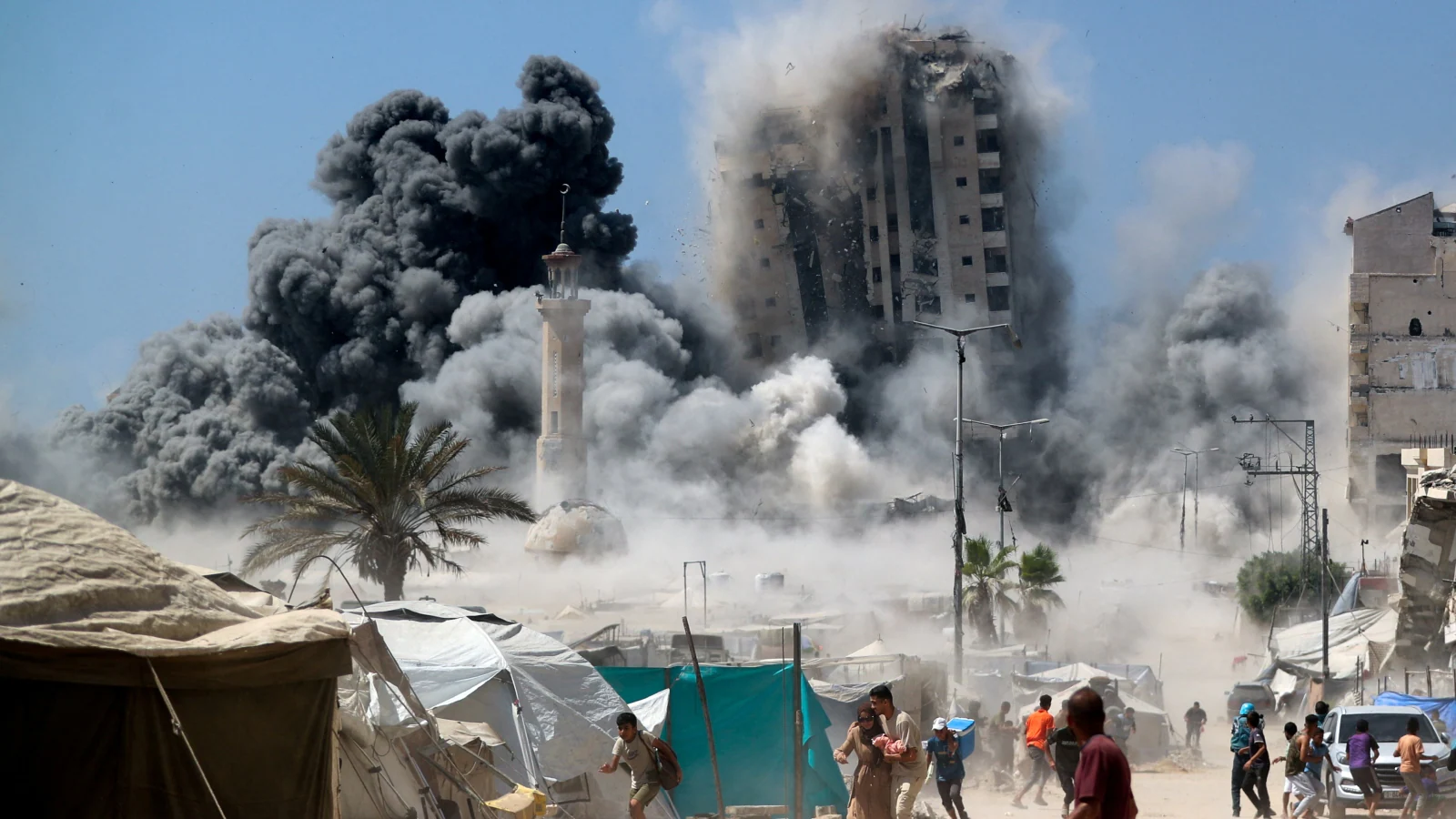By Karishma Jain,News18
Copyright news18

Israel has opened a new and dangerous chapter in its war against Hamas with a full-scale ground invasion of Gaza City. Tanks, drones, and remotely controlled explosive-laden vehicles are pushing into the enclave’s largest urban centre, long considered Hamas’s stronghold.
Israeli Prime Minister Benjamin Netanyahu called the offensive a “critical stage,” while Defence Minister Israel Katz declared on social media: “Gaza is burning.” According to an Israeli military official quoted by AP, between 2,000 and 3,000 Hamas fighters are believed to remain in Gaza City, operating mainly through an underground tunnel network and ambush tactics.
Officials from the Israel Defence Forces (IDF) told the Guardian that this phase differs from earlier raids in Rafah or Khan Younis. Unlike past operations where troops withdrew after temporary incursions, they said the plan now is to hold territory and eventually take full control of Gaza City. One official described the strategy as a “gradual manoeuvre” combining air and ground forces, aimed at dismantling Hamas’s central stronghold.
How Did The War Get Here?
The current conflict traces back to 7 October 2023, when Hamas launched a surprise cross-border assault into southern Israel, killing around 1,200 people, mostly civilians, and taking more than 250 hostages. The attack was the deadliest in Israel’s history.
Israel responded with a massive air and ground campaign across Gaza, vowing to destroy Hamas’s military and governing capacity. In the nearly two years since, Gaza has been devastated. Its health ministry says more than 64,000 Palestinians have been killed and over 160,000 injured, most of them civilians. Whole cities like Rafah and Khan Younis were bombarded and occupied. Gaza City had largely been spared total destruction until now.
How Are Palestinians Fleeing Gaza City?
The ground offensive has triggered one of the largest new waves of displacement since the war began. Israel has designated the al-Rashid coastal road as the main evacuation corridor, but the route is anything but safe. Eyewitnesses told local journalists that families were loading mattresses, cooking pots, and water containers onto cars and donkey carts, inching southward while airstrikes and shelling continued overhead.
The United Nations estimates that more than 220,000 people have fled northern Gaza in the past month, as Israel’s military buildup signalled an impending ground invasion. Israeli military officials, cited by Firstpost, estimate that around 40 per cent of Gaza City’s pre-war population, roughly 350,000 people, has already left.
According to figures by Hamas, about 175,000 residents fled south to other parts of Gaza, while another 350,000 relocated within Gaza City itself, moving to central and western neighbourhoods.
For those trying to escape, the journey comes at a steep price. Civilians told AP that private trucks charge up to $1,000 to ferry families south to Israeli-designated “humanitarian zones,” even as many are going hungry. Others have no means to leave at all. “It is like escaping from death towards death, so we are not leaving,” a woman in Gaza’s Sabra neighbourhood told Reuters.
Even those who make it out find little relief. UNICEF officials quoted by the Guardian warned that it is “inhumane” to expect nearly half a million children, already battered by almost two years of conflict, to trade one danger zone for another. Overcrowded encampments in southern Gaza, such as al-Mawasi, are bursting at the seams, lacking food, clean water, and medical care.
What Is The Humanitarian Situation?
The opening hours of the invasion brought hundreds of casualties. Gaza’s health ministry reported at least 93 people killed in northern Gaza on Tuesday alone, with more than 100 deaths across the enclave. Among them, local officials said, were families struck while trying to flee south.
Hospitals, already on the brink, are collapsing under the strain. Video footage from local journalists showed residents digging through debris of collapsed buildings, grieving families recovering the bodies of children, and doctors overwhelmed with waves of wounded.
In the Sheikh Radwan neighbourhood, where airstrikes have flattened homes, Maysar Al Adwan described the night-long bombardment to CNN: “Fear, fear, it’s all fear. Explosions over our heads, all day.”
Beyond the bombs, famine is tightening its grip. The Gaza health ministry says 428 people have died from starvation since the war began. UNICEF warns that 450,000 children in Gaza City face famine and severe trauma, with virtually no medical services available. Aid distribution has failed to keep pace; of 16 planned centres under a US-backed initiative, only five are functioning.
What Does The UN Genocide Report Say?
The ground invasion of Gaza City coincided with the publication of a 72-page legal analysis by the UN’s commission of inquiry, set up by the Human Rights Council in 2021 to investigate violations in the occupied Palestinian territories and Israel. Staffed by three independent experts, the commission does not formally speak for the UN as a whole but its findings carry significant weight.
Its latest report is the strongest yet. It concludes that Israel’s campaign in Gaza amounts to genocide, a term the UN itself has not officially used but is under growing pressure to adopt.
Under the 1948 Genocide Convention, adopted after the Holocaust, a state can be found guilty if it commits any of five acts “with intent to destroy, in whole or in part, a national, ethnic, racial or religious group.” The commission says Israel has committed four of these acts against Palestinians in Gaza:
Killing members of the group: UN reporting showed that by mid-July 2025, nearly half of those killed in Gaza were women and children. The Guardian, citing Israeli intelligence, reported that 83 per cent of the dead were civilians.
Causing serious bodily or mental harm: The report highlights mistreatment of detainees and mass displacement, which it says caused “serious and irreparable” harm to Palestinians.
Deliberately inflicting conditions of life calculated to destroy the group: Much of Gaza has been rendered uninhabitable. Schools and cultural and religious landmarks have been flattened. Hospitals have collapsed under bombardment and shortages, while famine has been declared in parts of the enclave.
Preventing births: The commission points to the destruction of Gaza’s largest IVF clinic in December 2023, which wiped out thousands of embryos and other reproductive material, as evidence of a pattern aimed at undermining the group’s biological continuity.
The report also cites speeches by Israeli leaders as proof of intent. Netanyahu’s November 2023 letter comparing the Gaza campaign to a “holy war of total annihilation,” along with remarks by President Isaac Herzog and then-defence minister Yoav Gallant, were listed as “direct evidence of genocidal intent.”
Israel has rejected the findings outright. Its ambassador in Geneva called the report “scandalous” and authored by “Hamas proxies.” The foreign ministry described it as “distorted and false.” Israeli officials maintain the campaign is lawful self-defence after the 7 October 2023 Hamas attack, which killed 1,200 people and led to the abduction of more than 250 hostages.
How Has The World Reacted?
Reactions have underscored Israel’s growing isolation. UN Secretary-General António Guterres called the situation “morally, politically and legally intolerable.” UN human rights chief Volker Türk urged the world to “scream for peace,” saying the carnage was “utterly unacceptable.” The Palestinian Authority accused Israel of committing “a war crime against humanity.”
European leaders are weighing sanctions. EU foreign policy chief Kaja Kallas warned the invasion would mean “more death, more destruction, more displacement,” and said measures such as suspending trade concessions were under discussion.
The United States remains Israel’s most significant backer but with nuanced tones. Secretary of State Marco Rubio acknowledged the narrow scope for diplomacy, saying a deal was unlikely “when you’re dealing with a group of savages like Hamas.” US President Donald Trump, meanwhile, warned Hamas of “hell to pay” if it used hostages as shields. Netanyahu, who faces protests at home from hostage families, is scheduled to meet Trump at the White House on 29 September after addressing the UN General Assembly.
Why Is This Offensive A Turning Point?
The Gaza City ground operation is significant for three reasons:
Military escalation: Israel is no longer conducting temporary raids but seeking permanent control of Hamas’s last major base, signalling a deeper and longer occupation.
Humanitarian catastrophe: With famine deaths rising, children at risk, and civilians paying exorbitant sums to flee only to find no safe haven, the crisis is reaching irreversible levels.
Legal and political stakes: The UN genocide report, coupled with EU sanctions talk, marks the sharpest global challenge to Israel’s conduct since the war began.
For Israel, the gamble is clear: deliver a decisive blow to Hamas but risk unprecedented isolation. Netanyahu has already told Israelis to brace for “an economy with autarkic features,” suggesting a shift toward self-reliance as trade ties come under pressure.



